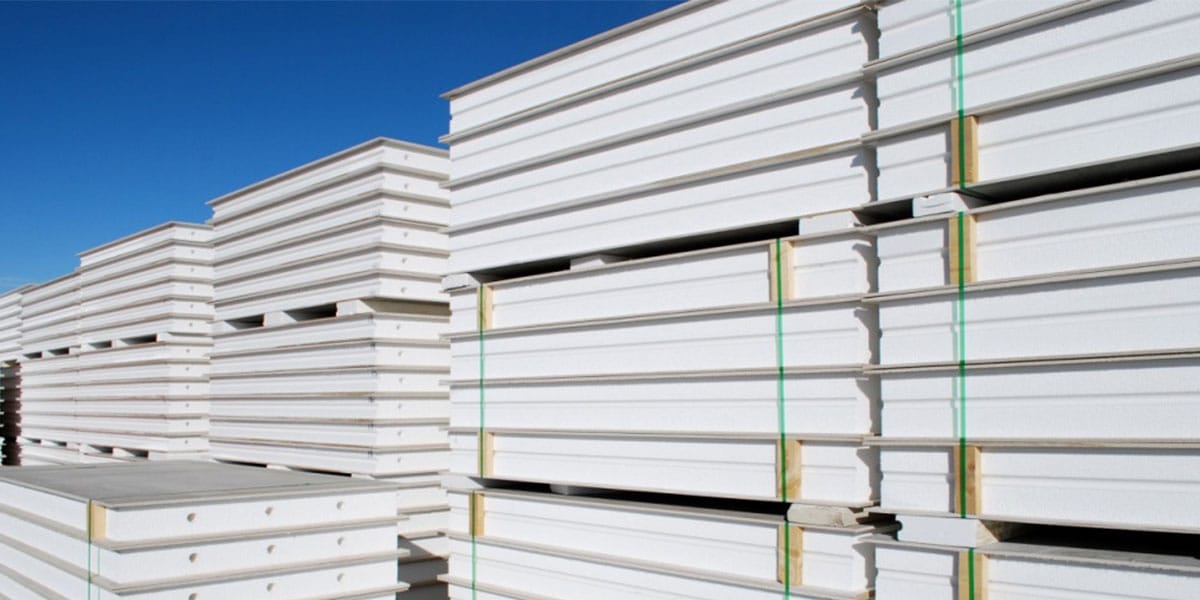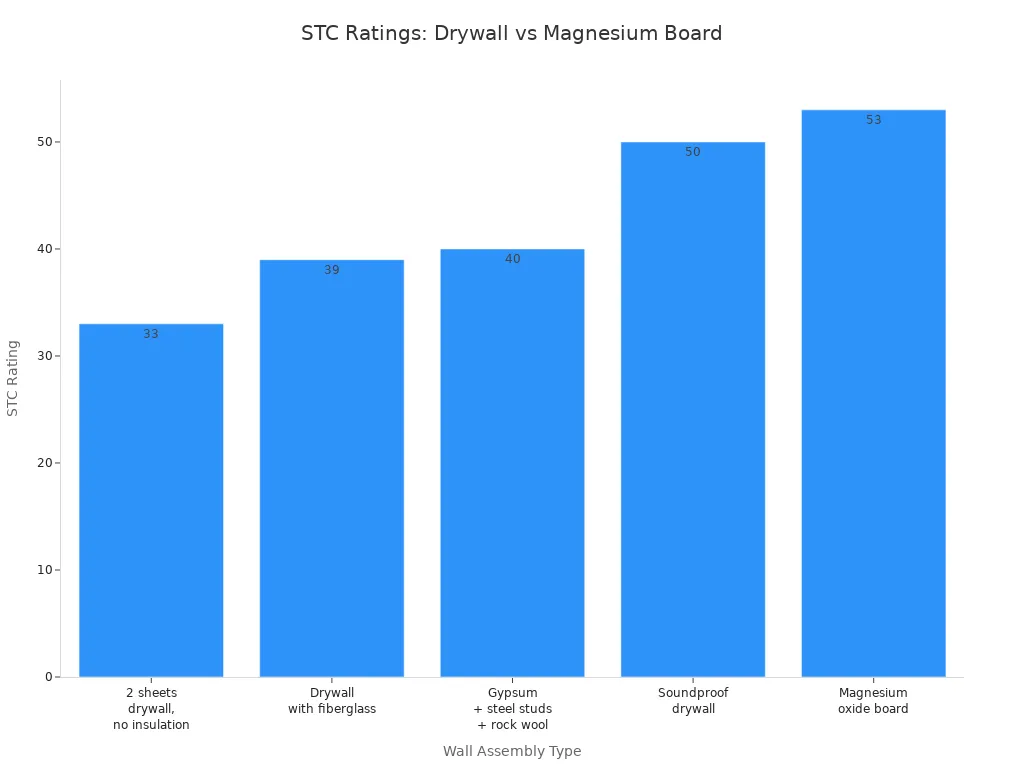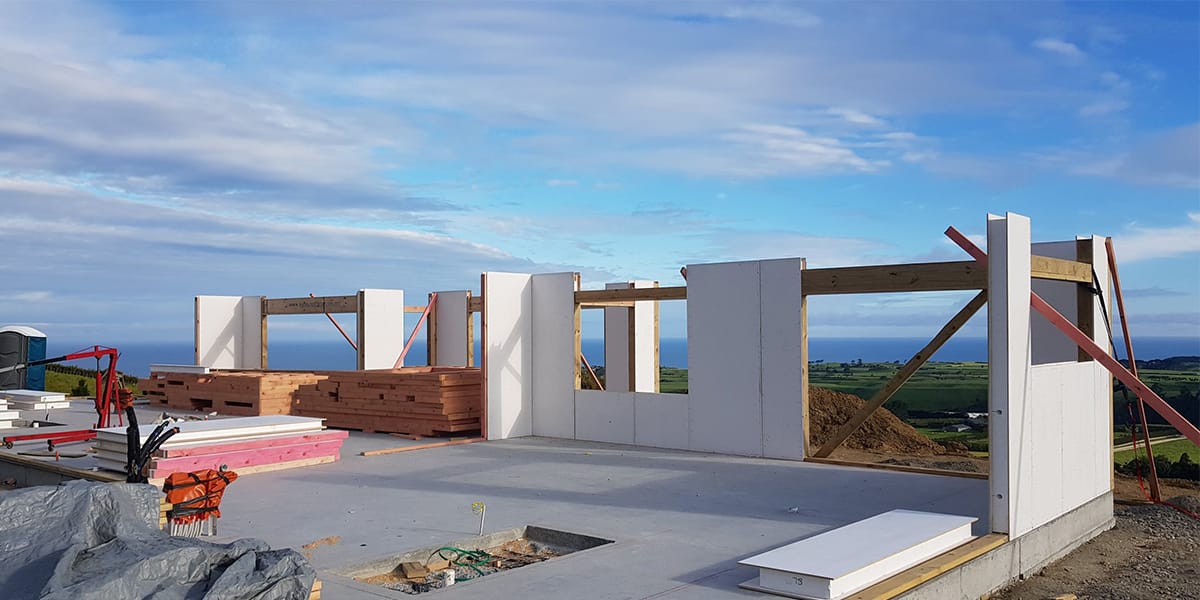
02 Sep Top Benefits of Magnesium Wall Boards for Sound Insulation
Table of Contents
Magnesium wallboard is great for sound insulation. It helps make rooms quieter, even when it is loud outside. Many builders pick mgo wallboard because it blocks noise well. It helps keep spaces calm and peaceful. Studies show mgo wallboard does more than just insulate. It also resists fire, moisture, and mold. It stays strong for a long time. The table below shows how mgo wallboard compares to regular wallboard:
Property | Mgo Wallboard | Drywall / Gypsum Board |
|---|---|---|
Moisture Absorption | Very low | Higher |
Mold Susceptibility | Low | High |
Fire Resistance | High | Low |
Strength | Very strong | Less strong |
Environmental Impact | Eco-friendly | Higher carbon impact |
People like mgo wallboard for its sound insulation. They also like its strength and eco-friendly features. This wallboard helps make indoor spaces healthier.
Key Takeaways
Magnesium wallboard stops sound better than regular drywall. It is thicker and heavier.
It does not burn easily. It also keeps out water and mold. This makes rooms safer and healthier.
These wallboards last a long time. They stay strong in wet or loud places.
Magnesium wallboard is simple to put up with normal tools. It helps finish building faster.
It costs more at first. But magnesium wallboard saves money later. It does not need many repairs.
Sound Insulation with Magnesium Wallboard
Dense Composition
Magnesium wallboard is good at stopping sound because it is thick. Builders use mgo wallboard in places where blocking noise is important. The wallboard has tiny holes spread out inside. These holes help soak up and quiet sound waves. It blocks noise in the air and cuts down shaking. Magnesium carbonate has a special crystal shape with small spaces. This lets it soak up sound from many kinds of noises. That is why mgo wallboard is picked for homes, schools, and offices.
Tests in labs show magnesium wallboard lowers noise that travels through the air. Its real power comes from stopping noise and echoes. Mgo wallboard keeps rooms quieter by blocking sounds people do not want. The sound reduction index tells how well a wallboard stops sound. Magnesium wallboard gets high scores for sound reduction, so it works better than regular drywall.
How Sound Is Blocked
Sound moves in waves. When sound waves hit a wallboard, the board can soak up, bounce back, or let the sound pass. Magnesium wallboard acts like a shield and soaks up sound waves. Mgo wallboard is thick and has a strong inside, so it blocks sound well. Its sound reduction index is higher than gypsum board. Mgo wallboard gets STC ratings of 53 to 54. Regular drywall does not score as high.
The chart below shows how STC ratings compare for different wallboards. Magnesium wallboard does better than old materials for blocking sound.

Mgo wallboard keeps blocking sound for a long time. It does not get ruined by water and stays strong. Its sound-blocking power does not change. Builders pick magnesium wallboard because it blocks sound well and lasts a long time.
Magnesium Wall Panel Benefits
Excellent Sound Insulation
Magnesium wallboard is great at stopping sound. Its thick panels block and soak up sound waves. This makes rooms much quieter. Builders like mgo wallboard because it blocks low sounds well. These sounds include voices, music, and cars. The sound reduction index for mgo wallboard is higher than most other materials. Some types, like DragonBoard MgO panels, get very high STC ratings, up to 59. EXACOR underlayment panels help meet or beat code rules for sound between rooms. These panels can reach STC 60 in tests, often without extra mats.
High STC ratings mean the wallboard blocks more noise. Mgo wallboard keeps loud sounds out and helps rooms stay calm.
Fire and Moisture Resistance
Magnesium wallboard is strong against fire. Tests give these panels a top Class A fire rating. The panels do not burn or help fire spread. Builders use mgo wallboard to get 1- or 2-hour fire safety ratings. They do not need extra treatments. This makes the wallboard safe for homes, schools, and offices.
Magnesium wallboard also fights moisture well. The table below shows how magnesium wallboard and gypsum board do in water tests:
Board Type | Water Impermeability Test Result | |
|---|---|---|
Magnesium Oxide (MgO) Board | 0.05 – 0.07 | Only small bits of moisture, which is fine |
Gypsum Board | 0.25 | Big water drops after one day |
Mgo wallboard does not soak up water, even after a long time. It stays strong and does not swell or break in wet places. Tests show mgo wallboard keeps its strength for years. Its fire and water resistance make it a good pick for many buildings.
Mold and Mildew Control
Mgo wallboard helps stop mold and mildew. The panels do not soak up water or break down. This keeps mold and mildew from growing, even in wet rooms. The wallboard stays strong and keeps its shape. This helps keep the air inside clean. People with allergies or asthma like mgo wallboard because it does not cause problems. The panels also keep bugs away, giving more protection.
Mgo wallboard does not swell or break when wet.
The panels stop mold and mildew from growing.
They help make indoor air healthier by lowering allergens.
Long studies show magnesium wallboard keeps blocking sound and stays strong, even in wet places. The panels do not crack or bend, and they need little care. This makes them smart for places with lots of moisture.
Non-Toxic and Recyclable
Magnesium wallboard is safe to use inside. The panels do not have formaldehyde, asbestos, or other bad chemicals. Many groups have checked their safety, like CE Marking, ISO 9001, and ICC-ES reports. Labs such as INTERTEK and ILAC-MRA test these panels for fire, strength, and chemicals. The panels do not let out bad VOCs, so they help keep air clean.
Certification/Testing Aspect | Description |
|---|---|
CE Marking | European safety and quality check |
ISO 9001 | Quality system certification |
ICC-ES ESR-2880 & ESR-5418 | Fire, rust, and strength tests |
VOC Report | Very low or no VOCs |
MSDS | No bad substances |
Magnesium wallboard is also good for the planet. The panels can be recycled or mixed into soil. They do not pollute landfills. Builders who want safe and green materials often pick mgo wallboard for their jobs.
Applications
 Residential
Residential
Magnesium wallboard makes homes quieter and safer. Builders use it in many places in a house.
It goes under floors to make a strong base that does not get moldy.
Builders put it on inside and outside walls for fire safety and to block noise.
Ceilings use these panels, especially in hanging ceiling designs.
Siding with magnesium wallboard can handle bad weather if finished right.
The wallboard helps hold up cladding and gives a good base for floors.
It works in wall sheathing, roofs, soffits, and fascias.
Structural insulation panels use magnesium wallboard to stop sound.
These panels are safe, light, and do not break easily.
People at home see less noise between rooms. Apartments, hotels, and offices use it to make sound better. The thick wallboard stops sounds people do not want and keeps rooms calm.
Commercial
Offices and hotels need quiet for work and sleep. Magnesium wallboard gives great sound blocking in busy places.
Offices use these panels to stop sound from moving, so people can focus.
Guests feel better and enjoy their stay more.
There are fewer complaints about noise after it is put in.
The wallboard is also strong, safe from fire, and saves energy.
Many businesses pick magnesium wallboard to make calm and good places to work.
High-Noise Areas
Places near airports, highways, or busy roads need more sound protection. Magnesium wallboard works well in these spots if put in the right way.
Let the wallboard get used to the room before putting it up.
Use special joint compounds or sealants for magnesium wallboard.
Attach panels with metal screws or anchors that do not rust.
Cut the wallboard to fit around outlets and pipes.
Leave a small space between the wallboard and the floor.
Check the wallboard often for any damage or wet spots.
Magnesium wallboard helps stop sound from moving in loud places. This makes homes, offices, theaters, and studios more private and comfortable.
Comparison with Traditional Materials
Drywall vs. Magnesium Wallboard
Drywall is used a lot in homes and offices. Magnesium wallboard works better in many ways. It blocks noise much more than drywall. Tests show magnesium sulfate boards stop more sound. This helps make rooms quieter. Magnesium wallboard is also tough and does not break easily. It does not crack or dent when hit. Drywall can tear or break if pushed hard. Magnesium wallboard is good for busy places like schools and hospitals.
Feature/Aspect | Magnesium Wallboard | Drywall |
|---|---|---|
Sound Blocking | High | Moderate |
Impact Resistance | Weaker, prone to damage | |
Moisture Resistance | Excellent, does not swell | Poor, swells and weakens |
Top rating, does not burn | Slows flames, weakens | |
Installation | Simple, uses standard tools | Easy, lightweight |
Gypsum Board vs. Magnesium Oxide Panel
Gypsum board is light and easy to put up. Magnesium oxide panel is heavier and blocks more noise. Its density is between 950 and 1050 Kg/m³. Gypsum board is less dense, from 640 to 800 Kg/m³. Magnesium oxide panel gives better sound insulation. Regular gypsum board has an STC rating near 30. Special soundproof gypsum boards reach 40 to 42. Magnesium oxide panel can get even higher ratings. It keeps rooms quiet, even when it is loud outside.
Magnesium oxide panel also fights water and fire. It does not soak up water. It stays strong, even when wet. Gypsum board takes in water and can fall apart. Magnesium oxide panel meets fire rules at only 3mm thick. Gypsum board must be much thicker to do the same.
Magnesium oxide panel stops mold and mildew.
Gypsum board can get moldy in wet places.
Magnesium oxide panel works in wet and fire-risk areas.
Cost and Installation
Magnesium wallboard costs more than drywall or gypsum board. The price is $16.15 to $37.67 per square meter. Gypsum board costs $3.22 to $10.76 per square meter. Magnesium wallboard saves money over time. It lasts longer and needs fewer fixes. It does not need to be replaced often because it resists water and fire.
Putting in magnesium oxide panel is quick and easy. Workers use normal tools. They do not need special training. Magnesium oxide panel goes in about 30% faster than gypsum underlayment. It does not need time to cure. Drywall and gypsum board need more work and curing time. Magnesium oxide panel helps builders finish jobs faster.
Magnesium wall boards help make buildings safer and more comfortable. They cut down on noise and do not burn or soak up water. These boards last longer than many old building materials. The table below shows how these boards help in different places:
Application Area | Key Advantage for Sound Insulation |
|---|---|
Residential Spaces | Cuts noise, making bedrooms and living rooms quieter. |
Commercial Spaces | Helps keep offices and public areas more private and quiet. |
Specialty Uses | Great for places where blocking noise is very important, like soundproof walls. |
Builders like magnesium wall boards because they are strong and easy to put in.
These panels also help the planet and make buildings healthier and quieter for everyone.
FAQ
What makes magnesium wallboard better for sound insulation than drywall?
Magnesium wallboard has a denser structure than drywall. This density helps block and absorb more sound waves. Builders choose it for rooms where quiet is important.
Can magnesium wallboard be used in bathrooms or kitchens?
Yes. Magnesium wallboard resists moisture and does not swell or break in wet areas. It works well in bathrooms, kitchens, and laundry rooms.
Is magnesium wallboard safe for people with allergies?
Magnesium wallboard does not support mold or mildew growth. It contains no harmful chemicals. People with allergies or asthma often feel safer with this material.
How long does magnesium wallboard last?
Magnesium wallboard stays strong for many years. It resists water, fire, and impact. Homeowners do not need to replace it often.
Does magnesium wallboard cost more than regular drywall?
Magnesium wallboard usually costs more at first. Over time, it saves money because it lasts longer and needs fewer repairs.

 Residential
Residential